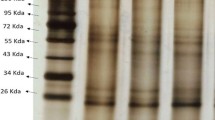Abstract
Addition of osmoprotective compounds has a positive effect on growth and monoclonal antibody production in hyperosmotic hybridoma cell cultures. In order to better understand the processes involved in the osmoprotective response, uptake of the osmoprotective compounds glycine betaine, proline, sarcosine and glycine in mouse hybridoma cell line 6H11 during exposure to hyperosmotic stress was studied. Hyperosmotic stress (510 mOsmol/kg) was introduced through the addition of NaCl (100 mM) to the growth medium, and amino acid transport activity was measured immediately after transfer of the cells to the hyperosmotic medium. The osmoprotective capability of the four osmoprotectants tested was negatively affected if methylaminosobutyric acid (MeAiB), a specific substrate for amino acid transport system A, was simultaneously included in the hyperosmotic medium in equimolar amounts with one of the osmoprotective compounds. This was due to accumulation of MeAiB in the stressed cells, giving a significant reduction in the concentration of the osmoprotective compound inside the cells. Furthermore, addition of excess meAiB gave approx. 905 reduction in the initial rate of uptake of glycine betaine, while 40–50% reduction in the initial rate of uptake of proline, glycine and sarcosine. Similarly, addition of proline, glycine or sarcosine also gave a significant reduction in the initial rate of glycine betaine uptake. These results suggest that the four osmoprotective compounds share, at least in part, a common, MeAiB inhibitable carrier for transport into osmotically stressed hybridoma cells. This carrier is probably equal to amino acid transport system A.
Similar content being viewed by others
References
Baker RD & George MJ (1971) Patterns of neutral amino acid uptake along rat small intestine. Biochim. Biophys. Acta 225: 315–325.
Chen J-G, Klus LR, Steenbergen DK & Kempson SA (1994) Hypertonic upregulation of amino acid transport system A in vascular smooth muscle cells. Am. J. Physiol. 267: C529-C536.
Christensen HN, Oxender DL, Liang M & Vatz KA (1965) The use of N-methylation to direct the route of mediated transport of amino acids. J. Biol. Chem. 240: 3609–3616.
Christensen HN (1975) Recognition sites for material transport and information transfer. In: Bronner F. & Kleinzeller A. (eds.) Current topics in membranes and transport. Vol. 6 (pp. 227–58) Academic Press, New York, USA.
Christensen HN (1979) Exploiting amino acid structure to learn about membrane transport. Adv. Enzymol. 49: 41–102.
Christensen HN (1985) On the strategy of kinetic discrimination of amino acid transport systems. J. Membrane Biol. 84: 97–103.
Dall'Asta V, Rossi PA, Bussolati O & Gazzola GC (1994) Response of human fibroblasts to hypertonic stress. J. Biol. Chem. 269: 10485–10491.
Dantzig AH, Slayman CW & Adelberg EA (1982) Isolation of a spontaneous CHO amine acid transport mutant by a combination of tritium suicide and replica plating. Somat. Cell Genet. 8: 509–520.
Guidotti GG, Borghetti AF & Gazzola GC (1978) The regulation of amino acid transport in animal cells. Biochim. Biophys. Acta 515: 329–366.
Hagihira H, Wilson TH & Lin ECC (1962) Intestinal transport of certain N-substituted amino acids. Am. J. Physiol. 4: 637–640.
Klip A, Mack E, Cragoe EJ Jr. & Grinstein S (1986) Regulation of amino acid uptake by phorbol esters and hypertonic solutions in rat thymocytes. J. Cell. Physiol. 127: 244–252.
Le Rudulier D, Strøm AR, Dandekar AM, Smith LT & Valentine RC (1984) Molecular biology of osmoregulation. Science 224: 1064–1068.
Oh SKW, Vig P, Chua F, Teo WK & Yap MGS (1993) Substantial overproduction of antibodies by applying osmotic pressure and sodium butyrate. Biotechnol. Bioeng. 42: 601–610.
Øyaas K, Berg TM, Bakke O, & Levine DW (1989) Hybridoma growth and antibody production under conditions of hyperosmotic stress. In: Spier RE, Griffiths JB, Stephanne J & Crooy PJ (eds.) Advances in animal cell biology and technology for bioprocesses. (pp. 212–220) Butterworth, London.
Øyaas K, Ellingsen TE, Dyrset N & Levine DW (1994a) Utilization of osmoprotective compounds by hybridoma cells exposed to hyperosmotic stress. Biotechnol. Bioeng. 43: 77–89.
Øyaas K, Ellingsen TE, Dyrset N & Levine DW (1994b) Hyperosmotic hybridoma cell cultures: Increased monoclonal antibody production with addition of glycine betaine. Biotechnol. Bioeng. 44: 991–998.
Øyaas K, Ellingsen TE, Dyrset N & Levine DW (1994b) Hyperosmotic hybridoma cell cultures: Increased monoclonal antibody production with addition of glycine betaine. Biotechnol. Bioeng. 44: 991–998.
Ozturk SS & Palsson BO (1991) Effect of medium osmolarity on hybridoma growth, metabolism, and antibody production. Biotechnol. Bioeng. 37: 989–993.
Petronini PG, De Angelis ME, Borghetti P, Borghetti AF & Wheeler KP (1992) Modulation by betaine of cellular responses to osmotic stress. Biochem. J. 282: 69–73.
Rotoli BM, Bussolati O, Dall'Asta V & Gazzola GC (1991) Membrane potential and amino acid transport in a mutant chinese hamster ovary cell line. J. Cell. Physiol. 146: 417–424.
Soler C, Felipe A, Casado FJ, McGivan JD & Pastor-Anglada M (1993) Hyperosmolarity leads to an increase in the repressed system A activity in the renal cell line NBL-1. Biochem. J. 289: 653–658.
Shotwell MA, Kilberg MS & Oxender DL (1983) The regulation of neutral amino acid transport in mammalian cells. Biochim. Biophys. Acta 737: 267–284.
Tramacere M, Petronini PG, Severini A & Borghetti AF (1984) Osmoregulation of amino acid transport activity in cultured fibroblasts. Exp. Cell Res. 151: 70–79.
Vidaver GA, Romain LF & Haurowitz F (1964) Some studies on the specificity of amino acid entry routes in pigeon erythrocytes. Arch. Biochem. Biophys. 107: 82–87.
Yancey PH, Clark ME, Hand SC, Bowlus RD & Somero GN (1982) Living with water stress: Evolution of osmolyte systems. Science 217: 1214–1222.
Author information
Authors and Affiliations
Rights and permissions
About this article
Cite this article
Øyaas, K., Ellingsen, T.E., Dyrset, N. et al. Transport of osmoprotective compounds in hybridoma cells exposed to hyperosmotic stress. Cytotechnology 17, 143–151 (1995). https://doi.org/10.1007/BF00749652
Received:
Issue Date:
DOI: https://doi.org/10.1007/BF00749652




